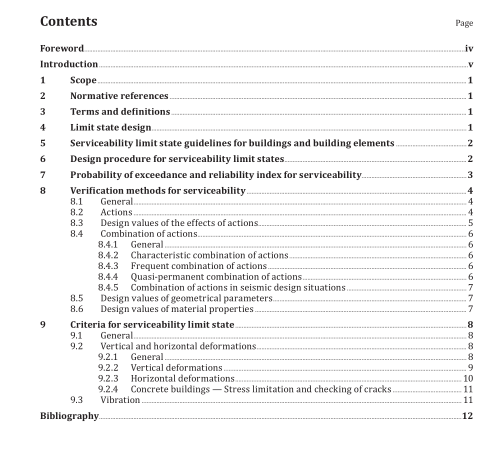ISO TR 4553:2022 pdf download.Deformations and displacements of buildings and building elements at serviceability limit states.
This document establishes the basic principles for the determination of deformations of buildings at the serviceability limit state when formulating national standards and recommendations. This document contains information on how serviceability for buildings and building elements is dealt with in some national standards.
2 Normative references
The following documents are referred to in the text in such a way that some or all of their content constitutes requirements of this document. For dated references, only the edition cited applies. For undated references, the latest edition of the referenced document (including any amendments) applies.
ISO 8930:2021, General principles on reliability for structures — Vocabulary
3? Terms? and? definitions
For the purposes of this document, the terms and definitions given in ISO 8930:2021 apply.
ISO and IEC maintain terminology databases for use in standardization at the following addresses:
— ISO Online browsing platform: available at https:// www .iso .org/ obp
— IEC Electropedia: available at https:// www .electropedia .org/
4 Limit state design
A structure or part of a structure, including a building and building elements, is considered unfit for use or to have failed when it exceeds a particular condition, called a limit state, beyond which its performance or use is impaired (e.g. ISO 22111:2019 [21] ). Generally, all designs are governed by the ultimate limit state and serviceability limit state.
The ultimate limit state primarily focuses on the maximum load-bearing capacity beyond which failureoccurs. The application of ultimate limit state in designs is commonly based on the assessment of either the impact of failure on loss of human life or personal injury, or both, and economic, social and/or environmental consequences. In major standards, different buildings and structures are assigned structural importance, consequence or risk classifications. Examples of these classifications can be found in the following standards:
a) AS/NZS 1170.0:2002, 3.3 for New Zealand, and Annex F: F2 for Australia [9] ;
b) prEN 1990:2020, 4.3, A.1.3, A.1.4 [11] ;
c) ISO 2394:2015, F.2 [17] ;
d) Table 2.4.1 of Reference [23];
e) ASCE 7-16, 2.2.1, Table 2.2.1 [10] .
These classifications are summarized in Table 1.
Additional considerations are given to special and essential buildings and infrastructures in order either to mitigate the hazards posed to community or to maintain functionality in the event of failure, or both. The design of this category of buildings and structures is usually governed by special guidelines and hence is beyond the scope of regular national standards. Serviceability limit state deals with the loss of functionality related to normal use. This document focuses on the serviceability limit states relating to the deformations and displacements of buildings and building elements.
5 Serviceability limit state guidelines for buildings and building elements Serviceability limit states for buildings and building elements are related to users’ comfort, loss of intended functionality to normal use and gradual deterioration. In these states, the modes of failure, i.e. undesirable states, include:
a) Unacceptable deflections/displacements (deformations): the acceptable limits are subjective and depend on human perception. A building with visible deflections (horizontal or vertical) is not acceptable by some members of the public, even when it is structural safe. The displacements limits often govern the design of a structure.
b) Excessive vibrations: they can cause discomfort to people or affect non-structural elements or functioning of equipment. The acceptability criteria are highly subjective and depend on human perception.
The design for vibration very often requires a dynamic analysis.
c) Local damage including cracking: They affect the appearance and functional reliability of the building. In concrete structures, they lead to steel corrosion, spalled concrete, salt penetration, and loss of concrete tensile strength.
It is important to distinguish reversible and irreversible serviceability limit states (e.g. ISO 2394:2015 [17] ). A reversible serviceability limit state is a state in which the effects of actions do not remain when the actions are removed, while an irreversible serviceability limit state is one in which the effects of actions remain even after the actions are removed. It is noteworthy that in practice, many serviceability requirements are subject to agreement between the owner and the designer. This document focuses on serviceability limit states relating to the deformations and displacements of buildings and building elements.
6 Design procedure for serviceability limit states
Most national standards recommend design procedure for buildings and building elements for serviceability limit states. These design procedures comply with the serviceability limit state design methodology adopted by individual national standard, such as those presented in: a) AS/NZS 1170.0:2002, 2.1, 2.3 [9] ;ISO TR 4553 pdf download.ISO TR 4553 pdf download
